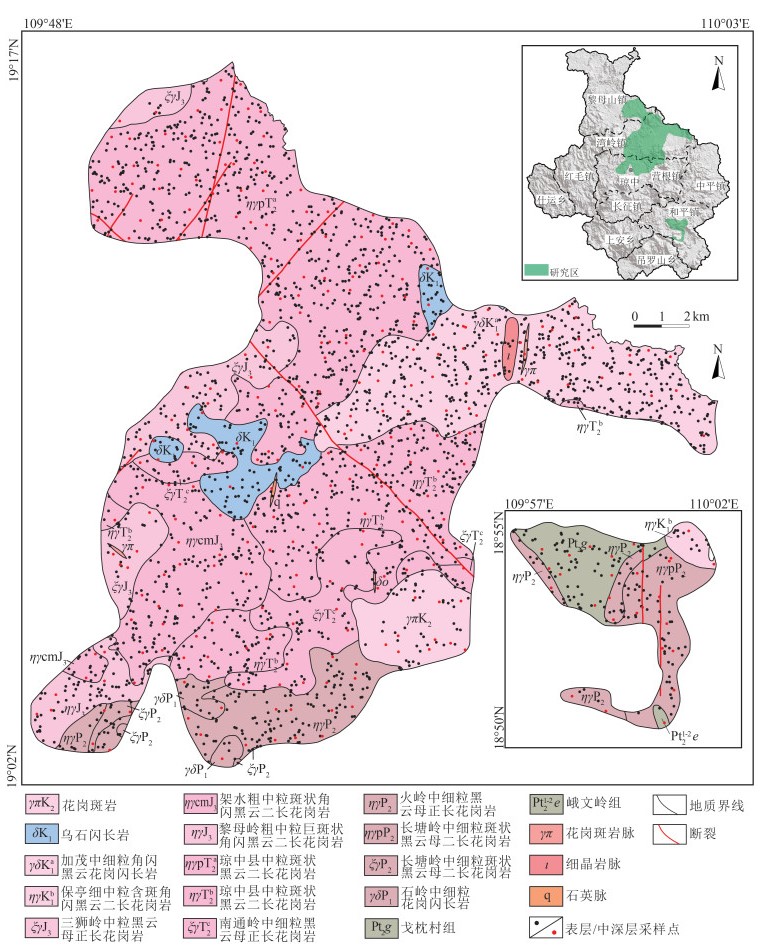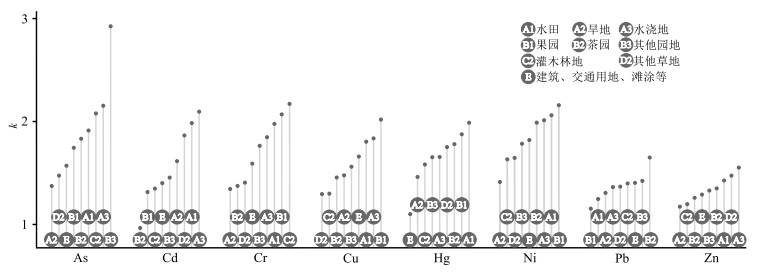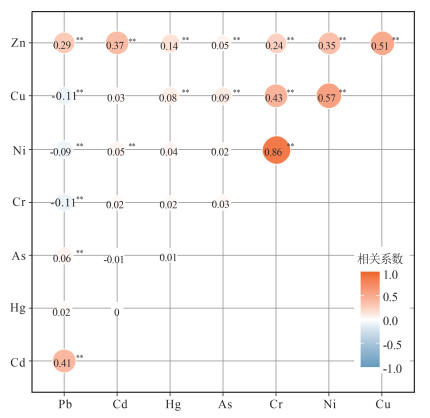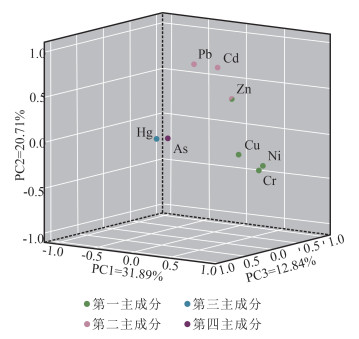Spatial distribution and ecological risk assessment of heavy metal pollution in the soil of Limu Mountain- Wanling Town, Qiongzhong, Hainan Province
-
摘要:
为了解琼中黎母山—湾岭地区土壤重金属元素分布特征及其潜在生态风险,采集了表层(0~20 cm)土壤样品2682件,对应中层(80~100 cm)及深层(180~200 cm)土壤样品各304件。分析测定Cu、Pb、Zn、Cr、Ni、Cd、As、Hg八种重金属元素。对8种重金属元素空间分布特征进行多元统计分析,并采用地累积指数法、潜在生态危害指数法对该区土壤重金属污染程度、生态风险进行评估。结果显示,表层土壤中8种重金属元素均值均高于海南岛土壤重金属背景值,表现出不同程度的积累;不同土地利用类型及种植类型对表层土壤重金属富集影响较大;垂向上,由表层至深层,土壤Pb、Zn、Cu、Cr、Ni五种重金属元素含量依次降低,但差异不大;Cd、As、Hg在垂向上表现出明显的表聚性。Pearson相关性分析与因子分析结果显示,Cu、Cr、Ni主要受地质背景影响,其余5种元素均受地质背景及人为因素影响。地累积指数结果显示,8种金属元素均值除Hg(0.08)外,均小于0,总体为无污染-轻微污染;生态风险评价显示,Cd和Hg为主要危害元素,Cd以轻微-中等危害为主,Hg以中等-强风险为主,其余元素危害指数均为轻微级,96%的土壤总体潜在生态危害指数在中等以下。
Abstract:In order to understand the spatial distribution and ecological risk assessment of heavy metal pollution in the soil of Limu Mountain-Wanling Town, Qiongzhong, 2682 topsoil samples(0~20 cm) and 304 middle-soil layer samples(80~100 cm) and subsoil samples(180~200 cm) were respectively collected to analyze for 8 heavy metal elements(Cu, Pb, Zn, Cr, Ni, Cd, As and Hg).Based on the metals' distribution, geoaccumulation index and potential ecological hazard index, multivariate statistics was conducted to evaluate the potential ecological risks.Results show that the mean values of 8 heavy metal elements in topsoils are higher than the soil background values of Hainan, showing different degree of accumulation effect.The accumulation of heavy metal in topsoils is associated with different land-use types and various planting patterns.Vertically, the contents of Pb、Zn、Cu、Cr、Ni decrease a little with depth, but contents of Cd, As and Hg are characterized by surface accumulation.Pearson correlation analysis and factor analysis suggest that Cu, Cr and Ni in the topsoils are mainly controlled by geological background, others are controlled by geological background and human activities.The mean geoaccumulation indexes of other heavy metal elements except for Hg(0.08) are less than 0.The ecological risk assessment show that Cd and Hg are the main hazard elements, Cd is mainly of slight to medium hazard, Hg is of medium to strong risk, and the hazard indexes of the other elements are all slight.The overall potential ecological hazard index of 96% of the soil is below medium hazard.
-
Keywords:
- Qiongzhong /
- soil /
- heavy metals /
- pollution /
- assessment /
- ecological risks
-
中国核工业地质局经过近20年的不懈努力,在中国北方陆相沉积盆地中相继发现和探明了一批大型、特大型砂岩型铀矿[1-2]。其中,鄂尔多斯盆地纳岭沟砂岩型铀矿床是中国北方最重要的砂岩型铀矿之一,随着开发试验的成功,即将成为中国重要的产铀基地之一。针对鄂尔多斯呼斯梁-皂火壕巨型铀成矿带的后生蚀变地球化学特征[3]、烃类流体特征[4]、灰绿色砂岩成因[5]等,前人已做过不少报道。但是,以往的研究主要以巨型铀成矿带东部东胜铀矿床(即皂火壕铀矿床)为研究区,而对位于巨型铀成矿带西部的纳岭沟砂岩型铀矿床的后生蚀变特征、成因探讨等研究较少。通过本次研究,进一步完善了纳岭沟铀矿床的成矿规律,为该矿床的经济有效开采提供地质依据。
1. 地质概况
研究区位于鄂尔多斯盆地北东部伊盟隆起南缘,其北为河套断陷,南为伊陕斜坡带,西为西缘逆冲带,东为晋西隆起[6-7]。地表断裂构造极不发育,但在岩心编录中可见较多的构造擦痕。主要出露中生代沉积地层[8](图 1),其中上三叠统延长组主要是为含砾砂岩和泥岩与粉砂岩互层,为产油层和煤层;中下侏罗统延安组岩性主要为长英质砂岩、泥岩和粉砂岩,产煤;中侏罗统直罗组是含矿目的层,主要由灰色、灰绿色砂岩及杂色粉砂岩和泥岩组成,平行或局部角度不整合于延安组之上;下白垩统岩性主要为砂砾岩,与下伏直罗组呈角度不整合接触关系。鄂尔多斯东北部砂岩型铀矿的找矿目的层为中侏罗统直罗组,找矿类型为层间氧化带型[9]。
2. 后生蚀变类型
后生蚀变是指在沉积成岩阶段后,由表生地下水将一些组分 (离子和化合物) 带出和带入, 致使岩石的化学成分和矿物组分发生重大变化[10]。庞雅庆[11]将东胜铀矿床后生蚀变作用分为3类:层间氧化蚀变,还原硫化物蚀变、油气还原蚀变。丁万烈等[12]依据能反映地下水氧化-还原环境的矿物-地球化学标志,将后生蚀变分为后生氧化蚀变和后生还原蚀变两大类。肖新建[13]认为,东胜区砂岩型铀矿后生蚀变作用可分为3期:早期是红色、黄色酸性氧化蚀变;中期是弱酸、弱碱性还原蚀变;后期是碱性还原蚀变。笔者根据与成矿作用的关系将后生蚀变分为控矿蚀变、成矿蚀变和保矿蚀变3类。
2.1 控矿蚀变
控矿蚀变又称为层间氧化蚀变,二连盆地巴彦乌拉矿床、伊犁盆地512矿床、吐哈盆地十红滩矿床等均具有由黄色、红色蚀变岩石构成的层间氧化带控矿特征。大量的岩心观察及实验室镜下薄片观察发现,纳岭沟铀矿床控矿蚀变主要表现为绿色古层间氧化,仅在灰绿色及钙质胶结岩石中可见不同程度地残留黄褐色、红色斑点、斑块或团块,或呈星点状、浸染状分布。绿色砂岩一般不含炭化植物碎屑、有机质细脉和黄铁矿,反映岩石遭受过较强的氧化作用,其中的有机质及黄铁矿均被氧化分解贻尽。另外,氧化带的绿泥石和高岭石含量较高,蒙皂石含量较低。岩石氧化作用较强,多位于碎屑边缘,部分位于岩屑中。金属矿物较少,主要为钛铁矿或磁铁矿,常遭受不同程度的氧化作用,部分黑云母被铁氧化物取代。碎屑粒间的粘土矿物较少,以高岭石为主。蚀变主要有绿泥石化、褐(赤)铁矿化、高铁氧化物、黄钾铁矾等。其中绿泥石化和褐铁矿化最常见。
岩石绿泥石化是本区蚀变的一大特征,最普遍的是黑云母的绿泥石化,蚀变产物为叶绿泥石[14];其次为斜长石或片岩的绿泥石化,蚀变产物为鳞绿泥石。薄片中可见黑云母和斜长石发生绿泥石化,呈淡绿色,鳞片状,干涉色低,有时具有黑云母的假象。其次为褐铁矿化,在绿色砂岩或致密砂岩中可见黄铁矿的褐铁矿化,呈斑点状或浸染状分布。薄片中可见残留的红褐色铁矿物,在碳酸盐胶结较强的薄片中常见,有时保留黄铁矿的假晶。
2.2 成矿蚀变
成矿蚀变在此指与铀矿富集相关的后生蚀变。通过电子探针、扫描电镜等手段进行分析研究,初步确认纳岭沟铀矿床矿石中铀存在形式有3种:吸附态铀、铀矿物及含铀矿物,且以吸附状态铀为主。研究认为,与成矿作用有关的蚀变主要为高岭石化、水云母化、黄铁矿化和碳酸盐化。
高岭石化在薄片中可见斜长石的高岭石化,呈无色、白色、淡绿色-淡黄色,正低突起。伴生微晶石英、长石、褐铁矿(化)、绢云母(化)等。
灰色砂岩中的水云母化常伴随赤铁矿化,主要是交代斜长石,沿其解理裂隙发育,部分交代黑云母,与此同时在填隙物中也可见水云母-赤铁矿化现象。因此,部分岩石显示玫红色长石和褐色斑点。具有该蚀变特征的砂岩铀矿富集品位较高。
灰色砂岩特别是矿石中见较多的黄铁矿,且黄铁矿赋存状态较多,常见类型为:① 与有机质相伴生的黄铁矿,细颗粒状,晶形完好,呈鲜艳的金黄色,为自生的黄铁矿,主要产于泥砾、泥质条带、泥质岩屑或泥岩薄层中;② 浸染脉状黄铁矿,主要产于灰色砂岩层中,沿砂岩层产出,不新鲜,肉眼不见晶形,为微细粒黄铁矿颗粒沿层分布的浸染脉体,可能为下部油气流体还原而成;③ 孤立产出的黄铁矿颗粒,一般产于泥质粉砂岩、泥岩中,呈团粒状,有的表面新鲜,有的表面不新鲜,反映受后期改造所致;④ 团块状黄铁矿,一般产于中砂岩中,有时沿层理面分布,晶形较完好,致密块状,团块状,有的呈致密球形,表面呈深灰色,与第一类黄铁矿相区别。
区内灰色砂岩碳酸盐化普遍发育,主要为方解石,常呈胶结物、分散的团块或粒状集合体、碎屑状产出。方解石胶结物或方解石脉具有多期演化的特征,但方解石作为胶结物或呈脉体状,都是砂岩层中后生蚀变晚期形成的,通常伴随下部油气流体的上升而发生。
2.3 保矿蚀变
保矿蚀变主要指还原性蚀变。层间氧化带砂岩型铀矿的富集需要一个长期稳定的还原障,从而保护铀矿体不受破坏。目前,在研究区北部有大量油砂岩的形成[15],在下白垩统可见多处油苗显示[16],且钻孔岩心中亦发现构造擦痕中有油斑显示。这充分说明,区内存在大量还原性介质。此外,研究区存在巨厚的绿色砂体,其蚀变岩石的地球化学特征反映该区遭受过后生还原蚀变。再者,矿石中铀石含量高,可能是沥青铀矿经过后期油气还原蚀变作用而形成的。
纳岭沟铀矿床C、O同位素组成分布较集中, 且未蚀变砂岩与绿色氧化砂岩结果十分相近,未蚀变砂岩δ13C最小值为-14.0‰,最大值为-5.1‰,平均值为-10.0‰;绿色氧化型砂岩δ13C最小值为-14.1‰,最大值为-6.7‰,平均值为-9.96‰。未蚀变砂岩δ18O最小值为16.3‰,最大值为22.8‰,平均值为16.3‰;绿色氧化型砂岩δ18O最小值为16.7‰,最大值为23.7‰,平均值为19.5‰。根据刘建明等设计的δ18O-δ13C图解(图 2)发现,样品基本落在沉积有机物脱羧基作用范围内[17]。也就是说,固体有机质提供了砂岩碳酸盐胶结物中的部分炭质来源。另外,在有机物脱羟基作用过程中形成了对铀运移沉淀具有重要意义的有机酸络离子[18],从而构成有机质流体的重要组成部分之一。蚀变矿物主要为黄铁矿,且主要为细晶质黄铁矿团块,这也是含矿砂体中常富含黄铁矿的原因之一。
![]() 图 2 纳岭沟铀矿床C、O同位素组成判别图[17]Figure 2. Carbon and oxygen isotope composition of the Nalinggou uranium deposit
图 2 纳岭沟铀矿床C、O同位素组成判别图[17]Figure 2. Carbon and oxygen isotope composition of the Nalinggou uranium deposit3. 后生蚀变空间分布规律
3.1 垂向分布规律
在剖面上直罗组下段上亚段几乎完全氧化,下亚段砂体氧化深度多在310~560m之间,绿色氧化砂岩一般为单层,垂向上呈上绿下灰的特征,绿色砂岩底界几乎处于同一标高。由北向南、由北西向南东,绿色古氧化砂岩厚度逐渐变薄,层数增多,具有层间氧化舌状体延伸的特点,灰色砂岩厚度增大。铀矿(化)体垂向上位于绿色古氧化砂体与灰色砂体的接触面上,呈板状分布(图 3)。由下往上,整体表现为保矿蚀变-成矿蚀变-控矿蚀变的垂向序列。
以绿色作为控矿蚀变的判别标志,根据钻孔资料及剖面对比结果,分别对纳岭沟铀矿床施工钻孔直罗组下段下亚段含矿含水层砂体中氧化砂体厚度、氧化砂体百分率(即氧化砂体厚度与总砂体厚度百分比)、氧化砂体底埋深和氧化砂体底标高等参数进行了统计。矿床内氧化砂体厚度大,最小氧化厚度为0m,最大氧化厚度为101.50m,平均为85.21m,变异系数为71.09%;氧化砂体底埋深最小值为283.20m,位于矿床东部,由北东向南西,氧化砂体埋深逐渐加大,最深达627.00m。
以钻孔ZKN4-62(图 4)为例,烧失量为3.6%~ 13.6%,平均值为7.0%;FeO为1.7%~4.8%,平均值为2.6%;有机碳为0.1%~1.1%,平均值为0.3%;S含量为0.01% ~0.24%,平均值为0.06%;无机碳为0.04% ~ 2.1%,平均值为0.7%;pH值为9.95~10.26,平均值为10.19;ΔEh值为21~120,平均值为40.7;Th为2.7× 10-6~18.4×10-6,平均值为6.3×10-6;U为0.7×10-6~ 52.6×10-6,平均值为10.4×10-6;Th/U值为0.06~6.7,平均值为2.7。
从氧化砂体底标高等值线图(图 5)可以看出,矿床区内氧化砂体底面标高一般为880~1120m,整体表现为北东高、南西低,由北东向南西方向氧化砂体底面标高逐渐变低,呈开口向南西方向的“U”形状,与地层产状基本一致,可能与东部底板抬升有关。矿床中部N8~N72号勘探线由北西向南东方向氧化砂体底面标高表现为“高-低-高-低-高”的“W”形特征,中部表现为局部高值,可能与含铀含氧水的迁移方向有关。倾向上平均每千米氧化砂体底面标高相差18m,氧化砂体底面倾角小于1°,说明纳岭沟铀矿床的氧化底面几乎处于同一水平面。
3.2 平面分布规律
从矿区氧化砂体厚度百分率等值线图(图 6)可以看出,氧化砂体百分率在0~100%之间变化。氧化砂体百分率高值区主要位于北部和东部,总体氧化方向以北西方向为主,由北西向南东逐渐变小,呈不规则“舌状体”向南东方向凸出,直至尖灭。此外,在矿床东部N112~N156号勘探线上表现为由北向南、由北东向南西百分率逐渐变小,说明除北西主氧化方向外,还存在由北东向南西方向的氧化。氧化砂体百分率为100%的区域即氧化带分布范围,主要位于研究区北部;氧化砂体百分率为0~100%的区域即过渡带分布范围,宽度7~ 10km,长度约15km;氧化砂体百分率为0区域即还原带分布范围,主要位于研究区南中部。对矿床内所有工业铀矿孔直罗组下段下亚段氧化砂体厚度百分率值进行统计,发现矿体主要分布在氧化砂体厚度百分率为50%~90%的区域。
4. 后生蚀变成因及其与铀成矿关系
4.1 控矿蚀变成因及其与铀成矿关系
后生氧化蚀变作用是砂岩型铀矿成矿重要的条件之一。绿色控矿蚀变砂岩绿泥石化和褐铁矿化较明显,具有低有机碳、低硫、低ΔEh、低铀等特征,未见黄铁矿及炭化植物碎屑,其中有机碳及S含量明显比灰色砂岩低,可见氧化蚀变作用造成了明显的褐铁矿化、有机质化、介质的酸化等,以及U含量的降低现象。灰绿色砂岩中全硫含量和有机碳含量略高于氧化残留砂岩,指示灰绿色砂岩受到后期还原蚀变作用。Th/U值较高,表明氧化带氧化砂岩中使U大量迁出,这时的铀主要以U6 +存在,以[UO2(CO2)2]2-和[UO2(CO2)3]4-形式迁移,为矿带铀的重新富集成矿提供了充足的铀源。氧化砂体的空间展布控制着矿体的空间分布区域。整个铀矿床主要位于过渡带内,只有北部和东部的少量钻孔位于氧化带内,还原带位于矿床南部。工业铀矿(化)体主要分布于氧化-还原过渡带内。
4.2 成矿蚀变成因及其与铀成矿关系
随着含氧含铀水在隔水层的封隔下在透水砂层中向前运移,氧逐渐被原生还原介质消耗,在有机质周围形成还原环境,随着弱酸-弱碱性还原地球化学障的出现,本区pH值一般为8.0 ~10.0,促使水溶液中的不同价铀还原沉淀。这时,大部分铀以分散吸附形式存在:① 铀呈离子形态分布在矿物的结晶水液体包裹体和粒间溶液中;② 铀被有机质、沥青质吸附在矿物结晶表面、解理面、裂隙面上;③ 铀以吸附形式存在于蒙皂石、高岭石、伊利石等粘土矿物组成的杂基中;④ 铀被黄铁矿、泥质、钛铁矿等吸附在胶结物表面;⑤ 铀多被煤屑、炭屑、有机质吸附。一部分为铀矿物,主要为铀石、沥青铀矿,见少量晶质铀矿、铀钍石和次生铀矿物。铀矿物多以黄铁矿为核心,附着在其边部。沥青铀矿是晶质铀矿的隐晶质变种,是本区常见的铀矿物,其颗粒微小,结晶程度低,往往与黄铁矿密切共生,围绕在黄铁矿表面或充填在裂隙中,与石英、方解石等共存。铀石是四价铀的硅酸盐,多与沥青铀矿、石英等共生,具有非均质、裂纹少的特性,围绕在钛铁矿、黄铁矿周边生长,或沿有机质边部发育。纳岭沟铀矿床铀的价态测试结果中U4+的比例均稍高,为53.08%~77.97%,平均值为60.55%,U6+稍低,所占比例为22.03%~46.92%,平均值为39.45%。高品位样品中U4+含量增加,为75 %左右,U6+为25%左右;低品位样品中U4+、U6+所占比例变化较大,U4+占9.32% ~71.92%,平均值为44.77%,U6+占28.08% ~ 90.68%,平均值为55.23%。整体上,高品位样品中U4+所占比例较大,而低品位样品中U6+所占比例较大,这一结果说明,高品位矿石富含沥青铀矿、铀石等铀矿物,低品位矿石则以吸附态铀为主。矿化砂岩中由于铀的沉淀而使CO2浓度增高,因此伴随黄铁矿等新生硫化物的生成及铀矿物的沉淀,矿化砂岩出现碳酸盐化现象。
4.3 保矿蚀变成因及其与铀成矿关系
后生还原蚀变作用也是砂岩型铀矿成矿的重要条件之一[11]。还原性流体在砂岩层中营造的相对地球化学封闭体系,可以避免砂岩铀矿床被氧化破坏。因为大气、地表水及浅部地下水含有的氧与充注于砂体中的还原性流体相互作用而消耗殆尽。因此,大量还原性流体能在垂向及侧向上保护矿体免遭后期氧化破坏。从矿化砂岩中铀矿物的类型也可以看出,纳岭沟铀矿床铀矿物中铀石含量高,铀石形成环境为碱性还原环境,因此其可能是沥青铀矿经过后期油气还原蚀变作用形成的。总之,后生还原蚀变作用不仅是铀矿还原沉淀的重要条件,还是铀矿床能够保存下来的重要条件。
5. 结论
(1)根据与成矿作用的关系建立了新的层间氧化带砂岩型铀矿后生蚀变分类方法,即可分为控矿蚀变、成矿蚀变和保矿蚀变3类。控矿蚀变又称为层间氧化蚀变,主要有绿泥石化、褐(赤)铁矿化、高铁氧化物、黄钾铁矾等。其中绿泥石化和褐铁矿化最常见。成矿蚀变在此指与铀矿富集相关的后生蚀变,主要有高岭石化、水云母化、黄铁矿化、有机质化和碳酸盐化。保障蚀变主要指还原性蚀变。
(2)分别从垂向和平面上分析了后生蚀变的空间分布规律。在剖面上绿色氧化砂岩一般为单层,铀矿(化)体垂向上位于绿色古氧化砂体与灰色砂体的接触面上,呈板状分布,由下往上整体表现为保矿蚀变-成矿蚀变-控矿蚀变的垂向序列。平面上以绿色作为控矿蚀变的判别标志,区内绿色氧化砂体底面标高整体表现为北东高南西低,与地层产状基本一致,可能与东部底板抬升有关。氧化砂体百分率高值区主要位于北部和东部,氧化方向以北西向为主,呈不规则“舌状体”向南东方向凸出,直至尖灭。矿体主要分布在氧化砂体厚度百分率为50%~90 %的区域。
(3)绿色控矿蚀变砂岩绿泥石化和褐铁矿化较明显,具有低有机碳、低硫、低ΔEh、低铀、高Th/U值等特征,铀主要以U6+存在,以[UO2(CO2)2]2-和[UO2(CO2)3]4-形式迁移,为矿带铀的重新富集成矿提供了充足的铀源。随着含氧含铀水在隔水层的封隔下在透水砂层中向前运移,氧逐渐被原生还原介质消耗,在有机质周围形成还原环境,随着弱酸-弱碱性还原地球化学障的出现,促使水溶液中的价铀还原沉淀。后生还原蚀变作用不仅是铀矿还原沉淀的重要条件,还是铀矿床能够保存下来的重要条件。
致谢: 感谢项目组所有成员的野外付出,感谢评审专家对本文提出的宝贵意见。 -
表 1 各指标分析方法及检出限
Table 1 The analytical methods and detection limits for various indicators
指标 分析方法 方法检出限/(mg·kg-1) Cu ICP 0.5 Pb ICP-MS 2 Zn XRF 2 Cr XRF 2 Ni ICP-MS 0.3 Cd ICP-MS 0.02 As AFS 0.2 Hg AFS 0.0005 Zn XRF 2 表 2 地累积指数污染评价标准
Table 2 Criteria for assessment of soil pollution with Igeo
地累积指数Igeo 级别 污染程度 Igeo < 0 0 无污染 0≤Igeo < 1 1 轻污染 1≤Igeo < 2 2 中污染 2≤Igeo < 3 3 中-重污染 3≤Igeo < 4 4 重污染 4≤Igeo < 5 5 重-极重污染 5≤Igeo 6 极重污染 表 3 Hakanson潜在生态危害指数评价标准
Table 3 Criteria for assessment of the potential ecological risk status with Eir & RI
生态危害 轻微 中等 强 很强 极强 Eir <40 40~80 80~160 160~320 ≥320 RI <150 150~300 300~600 600~1200 ≥1200 表 4 研究区表层土壤重金属含量特征
Table 4 Concentration distribution of heavy metals in topsoil in the study area
mg/kg 特征参数 Cu Pb Zn Cr Ni Cd As Hg 最小值 1 5.73 6.62 2.96 1.15 0.020 0.5 0.005 最大值 128 463 500 2110 488 15.2 105 0.172 均值 9.93 33.4 60.1 49.9 13.4 0.063 3.30 0.035 中位数 7.57 30.9 55.4 34.85 9.5 0.048 1.53 0.032 标准差 8.16 16.4 26.9 82.1 16.8 0.295 6.41 0.017 变异系数 0.822 0.490 0.449 1.64 1.25 4.66 1.94 0.478 海南岛土壤背景值 6.1 24.4 44.4 27.5 7.24 0.040 1.34 0.020 表 5 不同成壤母岩形成的土壤重金属平均含量
Table 5 Comparison of soil heavy metals contents by different parent rocks
mg/kg 成壤母质 样本数量 Cu Pb Zn Cr Ni Cd As Hg 黑云母花岗岩 634 11.59 29.73 62.49 64.55 17.29 0.06 2.65 0.04 闪长岩 91 21.43 26.38 78.44 106.98 25.75 0.08 6.18 0.03 花岗闪长岩 594 10.42 26.33 57.26 51.41 14.25 0.06 2.04 0.04 花岗斑岩 66 5.61 37.81 43.47 25.38 8.19 0.04 3.08 0.04 二长花岗岩 209 9.05 36.00 54.11 33.86 10.09 0.05 4.13 0.03 正长花岗岩 1018 8.57 36.99 60.01 39.67 10.48 0.07 3.60 0.03 石英闪长岩 2 5.22 47.00 34.70 40.75 11.73 0.04 1.18 0.02 云母片岩 1 3.78 24.60 48.10 3.75 1.44 0.19 10.20 0.01 斜长片麻岩 66 7.65 44.99 60.25 31.14 8.31 0.07 8.29 0.04 石英片岩 1 8.16 51.90 60.40 14.30 6.23 0.05 5.86 0.03 表 6 各重金属元素在不同深度土壤中含量相关性
Table 6 Correlation between heavy metals in topsoil and subsoil
元素 Pb-B Pb-Z 元素 Zn-B Zn-Z Pb-Z 0.78** Zn-Z 0.74** Pb-S 0.52** 0.62** Zn-S 0.63** 0.86 元素 Cd-B Cd-Z 元素 Cu-B Cu-Z Cd-Z 0.29** Cu-Z 0.81** Cd-S 0.15** 0.93** Cu-S 0.66** 0.88** 元素 Cr-B Cr-Z 元素 Ni-B Ni-Z Cr-Z 0.73** Ni-Z 0.80** Cr-S 0.72** 0.87** Ni-S 0.74** 0.90** 元素 As-B As-Z 元素 Hg-B Hg-Z As-Z 0.53** Hg-Z 0.55** As-S 0.24** 0.75** Hg-S 0.45** 0.72** 注:**表示在0.01级别相关性显著;元素符号后“-B”、“-Z”、“-S”分别代表表层、中层、深层土壤 表 7 因子分析旋转成分矩阵
Table 7 Rotated matrix of factor analysis
% 元素 成分 1 2 3 4 Ni 0.93 -0.01 -0.04 -0.04 Cr 0.87 -0.07 -0.10 -0.05 Cu 0.76 0.06 0.19 0.15 Cd 0.05 0.82 -0.06 -0.08 Pb -0.17 0.79 -0.01 0.08 Zn 0.49 0.61 0.27 0.07 Hg 0.01 -0.01 0.96 -0.02 As 0.03 0.01 -0.01 0.99 特征值 2.55 1.66 1.03 1.00 方差百分比 31.89 20.71 12.84 12.52 累积方差解释率 31.89 52.61 65.44 77.96 表 8 土壤重金属污染地累积指数分级
Table 8 The classification of heavy metals in soil based on the Igeo
重金属 指数均值 各级面积/km2 无污染 轻污染 中污染 中-重污染 重污染 重-极重污染 极重污染 Cu -0.25 160.57 87.41 26.16 3.20 0.40 0.00 0.00 Pb -0.23 194.08 80.29 3.06 0.27 0.04 0.00 0.00 Zn -0.28 184.53 89.47 3.71 0.02 0.00 0.00 0.00 Cr -0.29 165.71 78.08 27.28 4.57 1.38 0.49 0.21 Ni -0.18 158.19 81.15 31.70 5.03 1.43 0.20 0.03 Cd -0.26 176.85 87.56 12.74 0.54 0.02 0.00 0.02 As -0.08 180.65 50.77 22.75 12.93 7.95 2.21 0.47 Hg 0.08 123.08 140.37 13.18 1.11 0.00 0.00 0.00 表 9 土壤重金属的潜在生态危害指数统计
Table 9 Potential ecological risk coefficient for every heavy metal in soil
危害指数 重金属 分布范围 各级面积/km2 最小值 最大值 轻微 中 强 很强 极强 Cu 0.82 104.92 276.09 1.37 0.27 0 0 Pb 1.18 95.03 277.69 0.02 0.02 0 0 Zn 0.15 11.25 277.73 0 0 0 0 Ei Cr 0.22 153.34 276.83 0.58 0.32 0 0 Ni 0.79 337.02 274.44 3.05 0.15 0.06 0.03 Cd 14.63 11400.00 156.71 99.07 20.73 1.14 0.08 As 3.73 783.58 243.43 18.21 10.06 4.5 1.53 Hg 10.40 344.00 33.78 171.88 65.18 6.79 0.11 RI 36.06 11634.76 142.19 123.2 11.56 0.77 0.02 -
Ali L, Rashid A, Khattak S A, et al. Geochemical control of potential toxic elements(PTEs), associated risk exposure and source apportionment of agricultural soil in Southern Chitral, Pakistan[J]. Microchemical Journal, 2019, 147: 516-523. doi: 10.1016/j.microc.2019.03.034
Timofeev I, Kosheleva N, Kasimov N. Health risk assessment based on the contents of potentially toxic elements in urban soils of Darkhan, Mongolia[J]. Journal of Environmental Management, 2019, 242: 279-289. http://www.ncbi.nlm.nih.gov/pubmed/31054392
Cao S, Duan X, Zhao X, et al. Health risks from the exposure of children to As, Se, Pb and other heavy metals near the largest coking plant in China[J]. Science of the Total Environment, 2013, 472C: 1001-1009. http://www.sciencedirect.com/science/article/pii/S0048969713014289
Zhang X, Yang L, Li Y, et al. Impacts of lead/zinc mining and smelting on the environment and human health in China[J]. Environmental Monitoring&Assessment, 2012, 184(4): 2261-2273. http://labs.europepmc.org/abstract/MED/21573711
刘广深, 曾毅强, 洪业汤. 陆地生态系统中汞的迁移与富集研究的重要意义[J]. 矿物岩石地球化学通讯, 1994, (4): 216-217. https://www.cnki.com.cn/Article/CJFDTOTAL-KYDH404.010.htm 成杭新, 李括, 李敏, 等. 中国城市土壤化学元素的背景值与基准值[J]. 地学前缘, 2014, 21(3): 265-306. https://www.cnki.com.cn/Article/CJFDTOTAL-DXQY201403035.htm Lamb D T, Hui M, Megharaj M, et al. Heavy metal(Cu, Zn, Cd and Pb) partitioning and bioaccessibility in uncontaminated and longterm contaminated soils[J]. Journal of Hazardous Materials, 2009, 171: 1150-1158. doi: 10.1016/j.jhazmat.2009.06.124
Mahar A, Wang P, Ali A, et al. Challenges and opportunities in the phytoremediation of heavy metals contaminated soils: A review[J]. Ecotoxicology&Environmental Safety, 2016, 126: 111-121. http://europepmc.org/abstract/MED/26741880
刘瑞平, 徐友宁, 张江华, 等. 青藏高原典型金属矿山河流重金属污染对比[J]. 地质通报, 2018, 37(12): 2154-2168. http://dzhtb.cgs.cn/gbc/ch/reader/view_abstract.aspx?file_no=20181205&flag=1 张江华, 王葵颖, 徐友宁, 等. 小秦岭太峪水系沉积物重金属污染生态危害评价[J]. 地质通报, 2018, 37(12): 2224-2232. http://dzhtb.cgs.cn/gbc/ch/reader/view_abstract.aspx?file_no=20181213&flag=1 李福燕, 李许明, 吴鹏飞, 等. 海南省农用地土壤重金属含量与土壤有机质及pH的相关性[J]. 土壤, 2009, 41(1): 49-53. doi: 10.3321/j.issn:0253-9829.2009.01.009 何玉生. 海口城市土壤重金属污染特征与生态风险评估[J]. 生态学杂志, 2014, 33(2): 421-428. https://www.cnki.com.cn/Article/CJFDTOTAL-STXZ201402024.htm 徐方建, 闫慧梅, 田旭, 等. 海南岛东部陆架表层沉积物重金属污染评价[J]. 中国环境科学, 2016, 36(5): 252-261. https://www.cnki.com.cn/Article/CJFDTOTAL-ZGHJ201605036.htm Wang A, Wang Q, Li J, et al. Geo-statistical and multivariate analyses of potentially toxic elements' distribution in the soil of Hainan Island(China): A comparison between the topsoil and subsoil at a regional scale[J]. Journal of Geochemical Exploration, 2019, 197: 48-59. doi: 10.1016/j.gexplo.2018.11.008
湖北省地质调查院. 生态地球化学评价样品分析方法和技术要求(试行) DD 2005-03[S]. 2005. 中国地质调查局南京地质调查中心. 多目标区域地球化学调查规范(1: 250000) DZ/T 0258-2014[S]. 2014. 中国地质大学(北京), 国土资源部土地整理中心, 中国地质科学院地球物理地球化学勘查研究所, 等. 土地质量地球化学评估技术要求(试行) DD2008-06[S]. 2008. 吴燕玉, 周启星. 制定我国土壤环境标准(汞、镉、铅和砷)的探讨[J]. 应用生态学报, 1991, 2(4): 344-349. https://www.cnki.com.cn/Article/CJFDTOTAL-YYSB199104010.htm Muller G. Index of geoaccumulation in sediments of the Rhime River[J]. Geological Journals, 1969, 2: 109-118. http://ci.nii.ac.jp/naid/10030367619
鲍丽然, 邓海, 贾中民, 等. 重庆秀山西北部农田土壤重金属生态健康风险评价[J]. 中国地质, 2020, 47(6): 1625-1636. F rstner U, Ahlf W, Calmano W. Sediment quality objectives and criteria development in Germany[J]. Water Science&Technology, 1993, 28(8): 307-316. http://wst.iwaponline.com/content/28/8-9/307
崔邢涛, 栾文楼, 牛彦斌, 等. 唐山城市土壤重金属污染及潜在生态危害评价[J]. 中国地质, 2011, 38(5): 1379-1386. doi: 10.3969/j.issn.1000-3657.2011.05.024 代杰瑞, 庞绪贵, 宋建华, 等. 山东淄博城市和近郊土壤元素地球化学特征及生态风险研究[J]. 中国地质, 2018, 45(3): 617-627. https://www.cnki.com.cn/Article/CJFDTOTAL-DIZI201803015.htm 管后春, 李运怀, 彭苗芝, 等. 黄山城市土壤重金属污染及其潜在生态风险评价[J]. 中国地质, 2013, 40(6): 1949-1958. https://www.cnki.com.cn/Article/CJFDTOTAL-DIZI201306025.htm Hakanson L. An ecological risk index for aquatic pollution control a sediment to logical approach[J]. Water Research, 1980, 14(8): 975-1001. doi: 10.1016/0043-1354(80)90143-8
徐争启, 倪师军, 庹先国, 等. 潜在生态危害指数法评价中重金属毒性系数计算[J]. 环境科学与技术, 2008, 31(2): 112-115. doi: 10.3969/j.issn.1003-6504.2008.02.030 Wang A, Wang Q, Li J, et al. Geo-statistical and multivariate analyses of potentially toxic elements' distribution in the soil of Hainan Island(China): A comparison between the topsoil and subsoil at a regional scale[J]. Journal of Geochemical Exploration, 2018, 197: 48-59.
张素荣, 王昌宇, 刘继红, 等. 雄安新区西南部土壤重金属污染特征及生态风险评价[J/OL]. [2021-04-25]. 地学前缘, https://doi.org/10.13745/j.esf.sf.2020.7.1. Adrie V, Bert H. Sources of Cd, Cu, Pb and Zn in biowaste[J]. Sci. Total Environ., 2002, 300: 87-98. doi: 10.1016/S0048-9697(01)01103-2
Ottesen R T, Birke M, Finne T E, et al. Mercury in European agricultural and grazing land soils[J]. Applied Geochemistry, 2013, 33(Complete): 1-12. http://www.sciencedirect.com/science/article/pii/S0883292712003514
Martin M H. The Heavy Metal Elements: Chemistry, Environmental Impact and Health Effects[J]. Metais Pesados, 1990, 69(4): 354-356. http://www.onacademic.com/detail/journal_1000036171467710_db71.html
Garcia&Malz I, Millan E. Heavy metal contamination analysis of road soilsand grassesfrom Gipuzkoa(Spain)[J]. Environmental Technology, 1996, 17(7): 763-770. doi: 10.1080/09593331708616443
Gray C W, McLaren R G, Roberts A H C. The effect of long-term phosphatic fertilizer applications on the amounts and, forms of cadmium in soils under pasture in New Zealand[J]. Nutrient Cycling in Agroeco systems, 1999, 54: 267-277. doi: 10.1023/A:1009883010490
Sun Y, Zhou Q, Xie X, et al. Spatial, sources and risk assessment of heavy metal contamination of urban soils in typical regions of Shenyang, China[J]. Journal of Hazardous Materials, 2010, 174(1): 455-462. http://europepmc.org/abstract/MED/19825507
Kuo T H, Chang C F, Urba A, et al. Atmospheric gaseous mercury in Northern Taiwan[J]. Science of the Total Environment, 2006, 368(1): 10-18. doi: 10.1016/j.scitotenv.2005.10.017
Dy W, Xj S, Sq W. Accumulation and transformation of atmospheric mercury in soil[J]. Science of the Total Environment, 2003, 304(1/3): 209-214. http://www.ncbi.nlm.nih.gov/pubmed/12663184
曾希柏, 苏世鸣, 吴翠霞, 等. 农田土壤中砷的来源及调控研究与展望[J]. 中国农业科技导报, 2014, 16(2): 85-91. https://www.cnki.com.cn/Article/CJFDTOTAL-NKDB201402019.htm 中国地质调查局. 中国耕地地球化学调查报告(2015年). 国土资源部中国地质调查局, 2015. 傅杨荣, 杨奕, 何玉生, 等. 中华人民共和国多目标区域地球化学调查报告-海南岛. 海南省地质调查院, 2008.




 下载:
下载:










